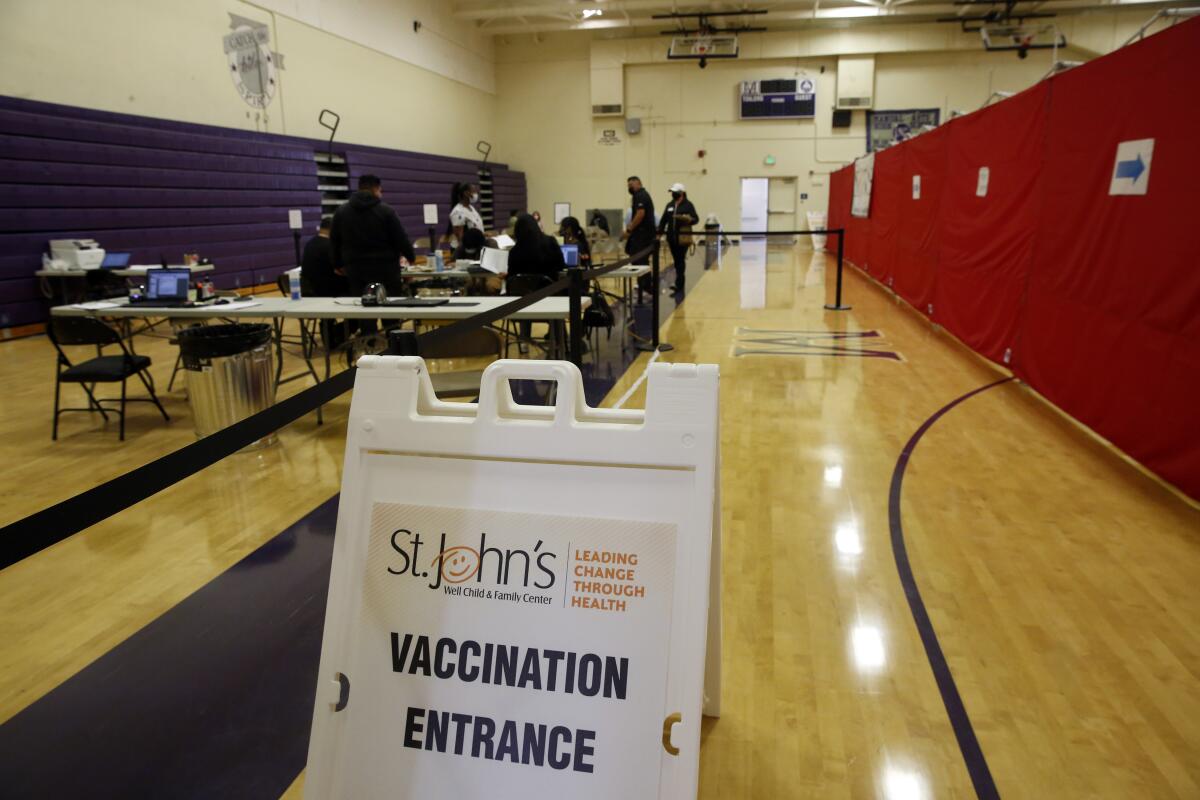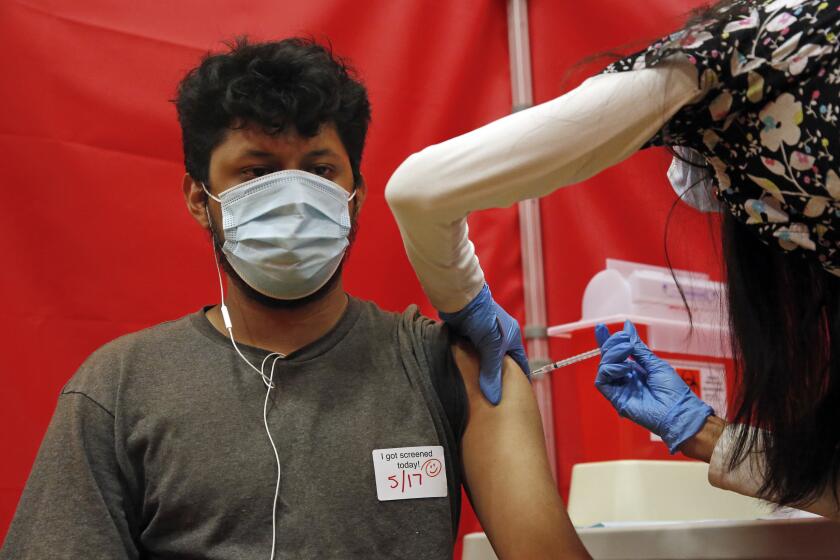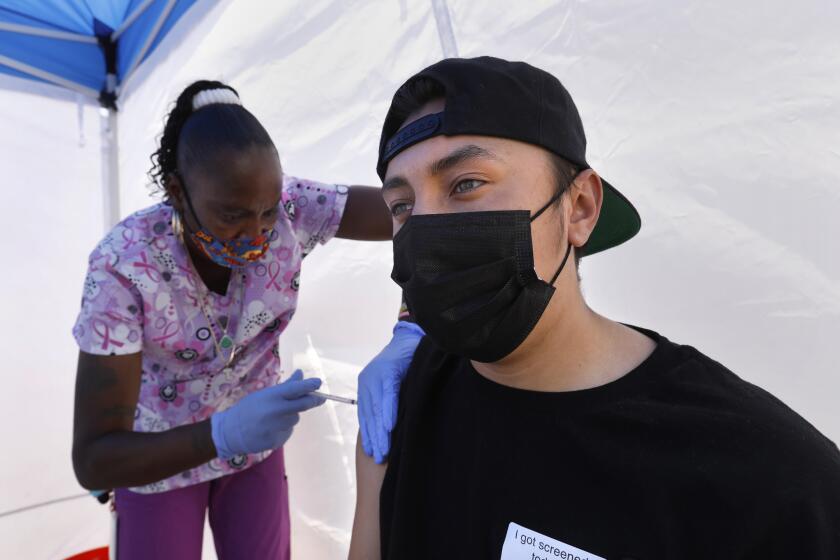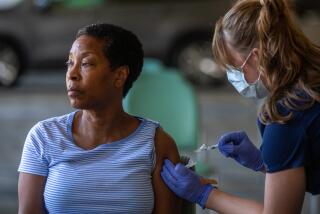Two-thirds of adults in California at least partially vaccinated

- Share via
Two-thirds of adult Californians are now at least partially vaccinated for COVID-19 — a hopeful milestone as the state trudges toward the level of widespread community protection officials and experts believe is necessary to end the pandemic once and for all.
To date, 67.3% of residents age 18 and older have gotten a vaccine dose, according to figures the U.S. Centers for Disease Control and Prevention posted Wednesday morning.
After a slow start, California now ranks 11th out of all states and is well above the national figure of 60.2%, federal data show. By comparison, the states with the highest levels of partial coverage for adults are Vermont, 78.6%; Hawaii, 77.1%; and Massachusetts, 75.9%.
California also measures up well compared to other large states. Roughly 68.2% of adults in Pennsylvania have received at least one shot so far, as have 64.7% in New York, 56.8% in Florida and 54.7% in Texas.
“We continue to urge, from the mountaintop, if you will, all Californians to get vaccinated to ensure that infection and hospitalization rates remain low across the state and that we can all return to those activities we love and have been missing for so long,” Dr. Mark Ghaly, California’s Health and Human Services secretary, said this week.
Current rules require all workers in the state to wear a mask indoors and keep six feet away from others.
Of the COVID-19 vaccines currently available in the United States, the single-shot offering from Johnson & Johnson and Moderna’s two-dose regimen are eligible only for use in adults.
The third, from Pfizer-BioNTech, was initially offered to people 16 and older, though regulators expanded use of those shots to children as young as 12 just last week.
So far, 63.2% of all eligible Californians — that is, those who are at least 12 years old — have received at least one dose, and 46.2% are fully vaccinated, federal data show. Nationwide, those figures are 56.8% and 44.8%, respectively.
Extending vaccine eligibility, officials and experts say, is key to eventually reaching the level of community immunity believed necessary to starve the coronavirus of additional hosts to infect.
While estimates of that herd immunity threshold vary, it’s typically pegged at or above 80%.
That bar is high, but not impossible to clear. Officials said last week that Los Angeles County could reach herd immunity from the coronavirus among adults and the oldest teenagers at some point in mid- to late July.
And, so far at least, there does appear to be an appetite for vaccines among those who are newly eligible. As of late Friday, just the second day the shots were available, more than 15,700 Angelenos between the ages of 12 and 15 had been inoculated, according to county figures.
While staffing a vaccination site over the weekend, county Public Health Director Barbara Ferrer said she saw “hundreds of teens that showed up to get their first dose — many relieved, and some who were scared but determined to get back to doing activities they’ve missed so much this past year.”
“I know that, for some of you, this has been a very hard decision,” she said during a briefing Monday. “And I encourage those not yet sure about when and if to get vaccinated to talk to your friends and family who already did get vaccinated. Many of the fears are based on false information circulating widely through social media, including that vaccines are linked to infertility or can make others sick. Neither of these is possible.”
Vaccination rates are especially low among Latino men. Misinformation, fear and busy schedules all play a role, experts say.
While getting as many people vaccinated as quickly as possible is vital, officials say it’s just as important to make sure that doses are being offered and administered equitably, so that no one is left behind.
Here, there is still more work to do. According to data compiled by The Times, 65% of Latino Californians and 64% of Black residents have not yet been vaccinated, compared with 52% of American Indian/Alaska Natives, 48% of whites and 38% of Asian/Pacific Islanders.
Demographic information is incomplete, however, because available state data do not categorize the race of roughly 16% of those who have been vaccinated.
“We continue the relentless focus on delivering vaccines, particularly to underserved communities and those that were hard hit throughout this pandemic,” Ghaly said.
In L.A. County, only 37% of Black residents and 41% of Latino residents ages 12 and older have received one dose of a vaccine, compared with 57% of American Indian and Alaska Native residents, 60% of white residents and 67% of Asian residents.
“Given this reality, and the ongoing need to increase vaccination rates among Black and brown residents, our focus has shifted to eliminating barriers to getting vaccinated and building confidence in the vaccines,” Ferrer said.
Times staff writer Jaclyn Cosgrove contributed to this report.
More to Read
Sign up for Essential California
The most important California stories and recommendations in your inbox every morning.
You may occasionally receive promotional content from the Los Angeles Times.













